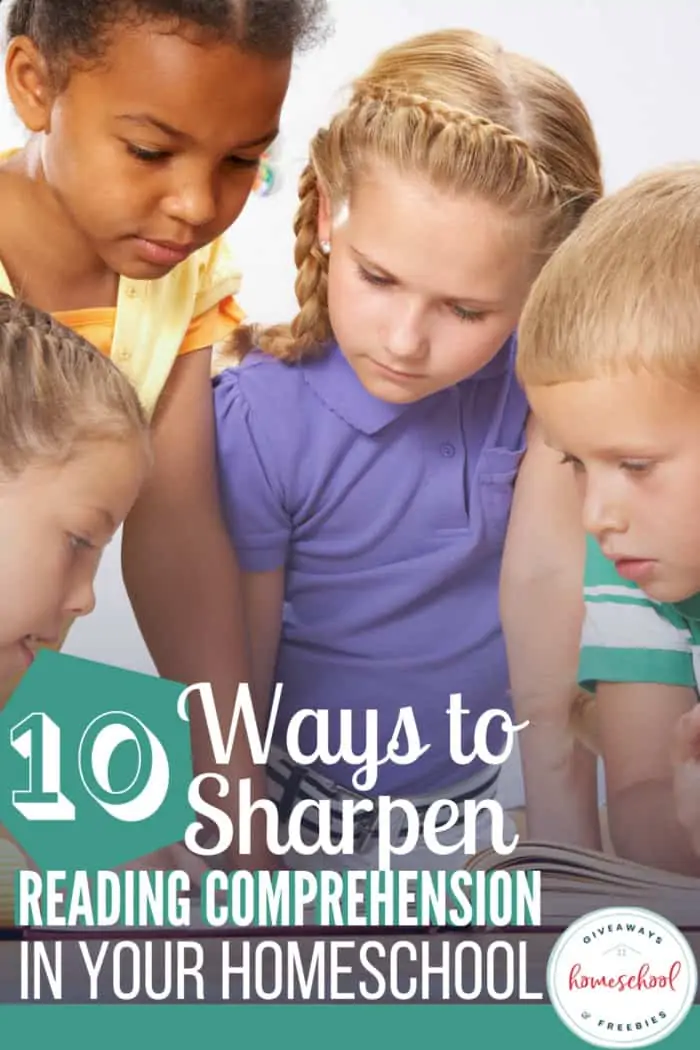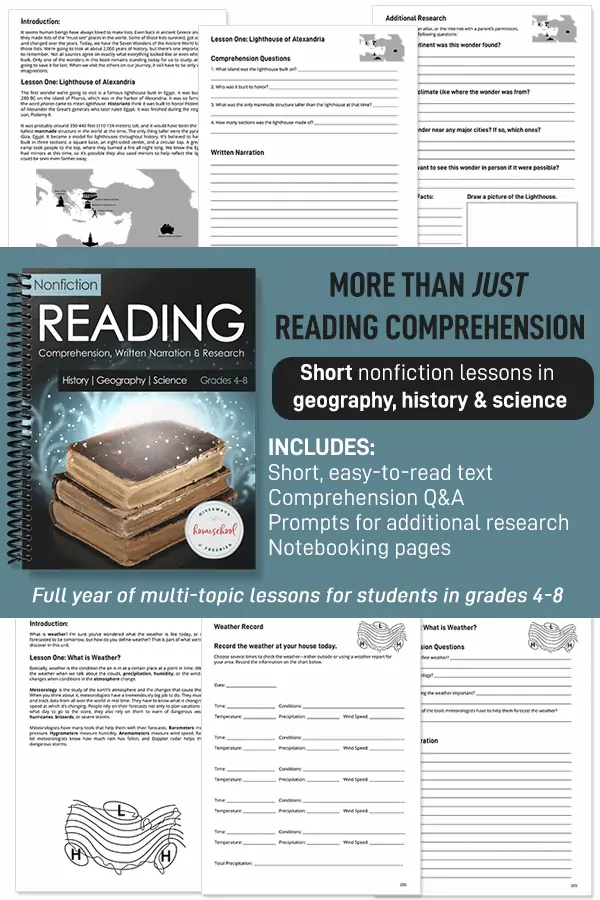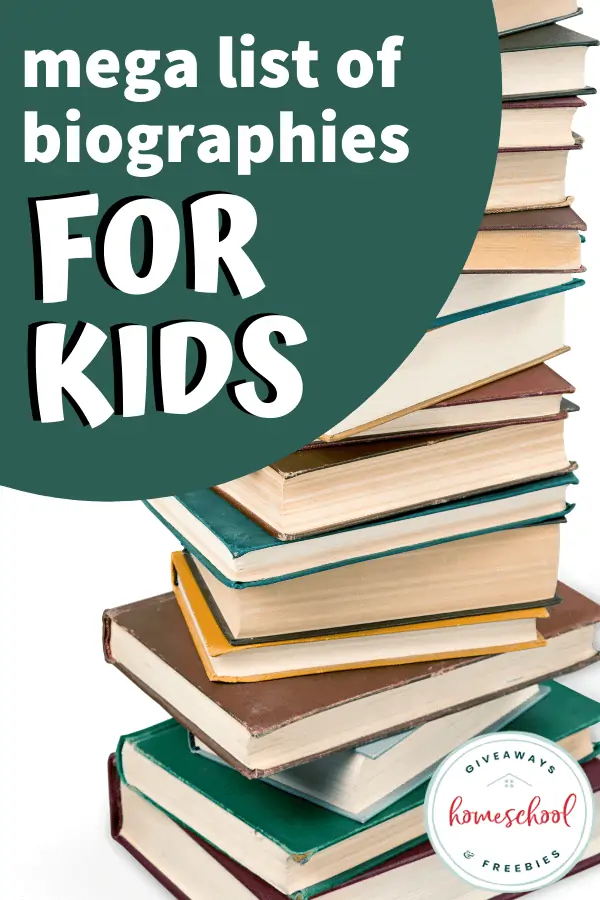10 Ways to Sharpen Reading Comprehension in Your Homeschool
Published:
March 5, 2020
Contributor:
Jeannette Tuionetoa
Disclosure: This post may contain affiliate links, meaning if you decide to make a purchase via my links, I may earn a commission at no additional cost to you. See my disclosure for more info.
As homeschoolers, we fully know that teaching our children can be a challenge. Some subjects and concepts are easier to teach than others. Reading comprehension is one of the harder ones, for me anyway. Understanding what they read is not something kids can memorize or isn’t a formula for them to follow. Explore these 10 ways to sharpen reading comprehension in your homeschool.
When kids learn to read, it’s such a huge feat. We are so excited to have them read words and be comfortable doing it. Then we realize what the very next progression is – comprehension. The next step is making sure kids can actually understand what they are reading.
It is like climbing a mountain, getting to the end, just to realize it only leads to another mountain to conquer. Reading comprehension is its own mountain. We can’t just ask one question to see if a child really got the gist of their reading assignment. It has to get deeper than that.
Helping our children to understand what they are reading is not easy for many of us. My son is 10 now, and I still find that it’s hard for him to grasp the ideas of longer passages. Once kids figure out smaller passages, they have to comprehend longer and more difficult passages. It takes effort and lots of practice for kids to grasp how to read with full comprehension. So we give them a little help.
Check out these 10 ways to sharpen reading comprehension in your homeschool:
1. Read to your children as early as possible, even in the womb.
Reading to children early gets them in a habit to read, and it gets them used to listening. Cultivate a habit of reading in your home. Making reading another part of their homeschool/home routine will help your kids to love it. When they are little, read to them daily. As they grow, have them read themselves and often.
2. Emphasize fluency.
Building fluency in reading takes away frustration for the reader. How can we improve reading comprehension when a child is busy trying to sound out words. If they have to sound them out, there may be a chance they don’t know the word they are reading. That brings me to the next idea.
3. Be intentional about building vocabulary to help with reading comprehension.
I am sure you have heard a saying that says knowledge is power. I have found that learning new words has given me the power and confidence to speak up when I need to and to understand different points of view. Provide your children with an ever-increasing vocabulary for them to “get the words they are reading.” If they don’t understand some words, then task them to write those words down as their vocabulary for the week.
4. Create a comfortable designated reading space.
I remember having a reading nook as a teacher in an early learning center. Kids will switch stations, and so they had a particular time and place for reading. I think the concept is the same here.
Create a space where they understand the parameters are to lounge and read. This may not make sense to you right now, but it will. When you realize that reading comprehension isn’t only about the words in a text, you will get it. It is about paying attention to context clues, connections, and focusing on character. It’s difficult to concentrate and comprehend such things in a chaotic space.
5. I probably cannot emphasize this enough – ask questions.
The habit I got into when reading with my kids a few years back was this – the RQWs. We would read a passage once; then, we would read again. I then ask questions throughout the passage. I ask as many as I can for their memory and to see if they were paying attention. It allowed me to gauge my children’s level of interest. Once they can answer those questions, I can then move on to questions that make them think – critical thinking questions.
For instance, instead of asking what color rain boots Allie wore, I can ask why she was wearing rain boots. Ask, ask, and ask again. Your kids may gradually form a habit of asking their own questions. These leads then to ask these questions to themselves as they read on their own.
6. Have your children read books at their right reading level.
I know it may be some work to make sure our kids have reading material that matches their level of comprehension of the text. It is absolutely worth it to make sure this is happening.
Get online and print out some reading level lists of the level you think your child may be in. Grab some books from the Library to evaluate where they need to be, then build from there. Trust that reading levels can guide your children to understand what they are reading gradually.
7. Have your kids take notes.
Sometimes even as adults, we read a book and love it but miss something we wish we hadn’t. With me, that means I may need to reread the book or rewind my chapters to make sure I am not missing anything.
Your kids can get in the habit of taking notes, as it also lets kids capture what they are reading with two learning styles. That is always a win/win.
8. Whenever possible, provide context for what the kids are learning.
This can be done with very young kids straight up to high school-aged kids. For instance, if your young learner is reading a book about brushing their teeth. First, ask what they know about the dentist or why they think they should keep their teeth clean. If your child is reading Helen Keller’s book, it would be wise to learn about the Holocaust to set the scene of where her writing was coming from.
A little bit of background helps us to understand the text and to make connections more readily.
9. Talk about their reading with them.
There have been many times after my daughter has read a book, I discover there were some things she didn’t understand. If your child is reading on their own, make it a habit to get a summary of their reading when they are done.
This can be done with only a discussion or more formally in a summary exercise. Either way, this wrap up of books allows us to help kids fill in gaps and answer questions they may have had but never asked about their reading
10. Practice all you can.
Here are some printables and resources to help you build, develop, and improve your child’s reading comprehension skills.
FREE Old Testament Bible Stories Reading Comprehension Unit
Reading Comprehension with Fairy Tales
Reading Comprehension Graphic Organizers and Templates and Part One and Part Two
29 Reading Comprehension Resources
Decodable Text Passages FREE Pairs Well With Orton Gillingham Phonics First 11 | Special Adventures
Reading Comprehension Bookmarks | 123Homeschool4Me
Kindergarten Reading Comprehension Worksheets | Itsy Bitsy Fun
Improve reading comprehension with this FREE children’s book about Kenya! | The Measured Mom
Comprehension Questions | Ciera Harris Teaching
Differentiated Reading Passages and Questions FICTION FREE | Practical Primary Teacher
FREE Reading Comprehension Cut and Paste and FREE Reading Comprehension and FREE Reading Activities for Beginning Readers | Miss Faleena
Reading Comprehension Passages & Questions (“WH” Questions) – 1st Edition – FREE | Fun and Learning in English and Spanish
FREE Reading Passage with Comprehension Questions – First Grade – Kindergarten | Keeping My Kinders Busy
Printables Reading Comprehension Sheets with 1st Grade Sight Words | Jenny at Dapperhouse
FREE Kindergarten Reading Comprehension Practice Passages | Kaitlynn Albani
When we sharpen reading comprehension in our homeschool, we are growing readers that are aware. They can read and understand if something is not quite right or at best be able to question what they are reading. That is increasingly important in the information age we live in today. Grow readers who love reading. Grow readers who ask questions and who read as a part of their lives. It is a precious and enriching gift we can give them.












